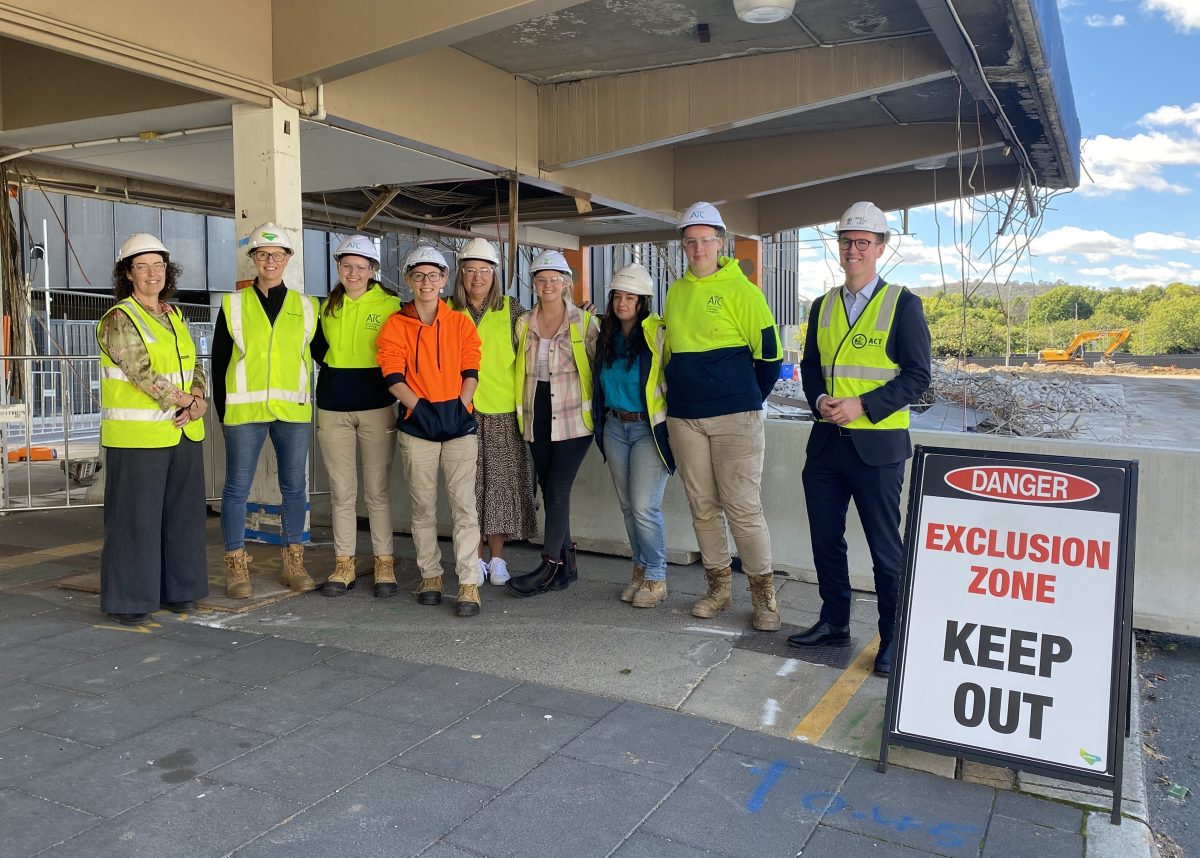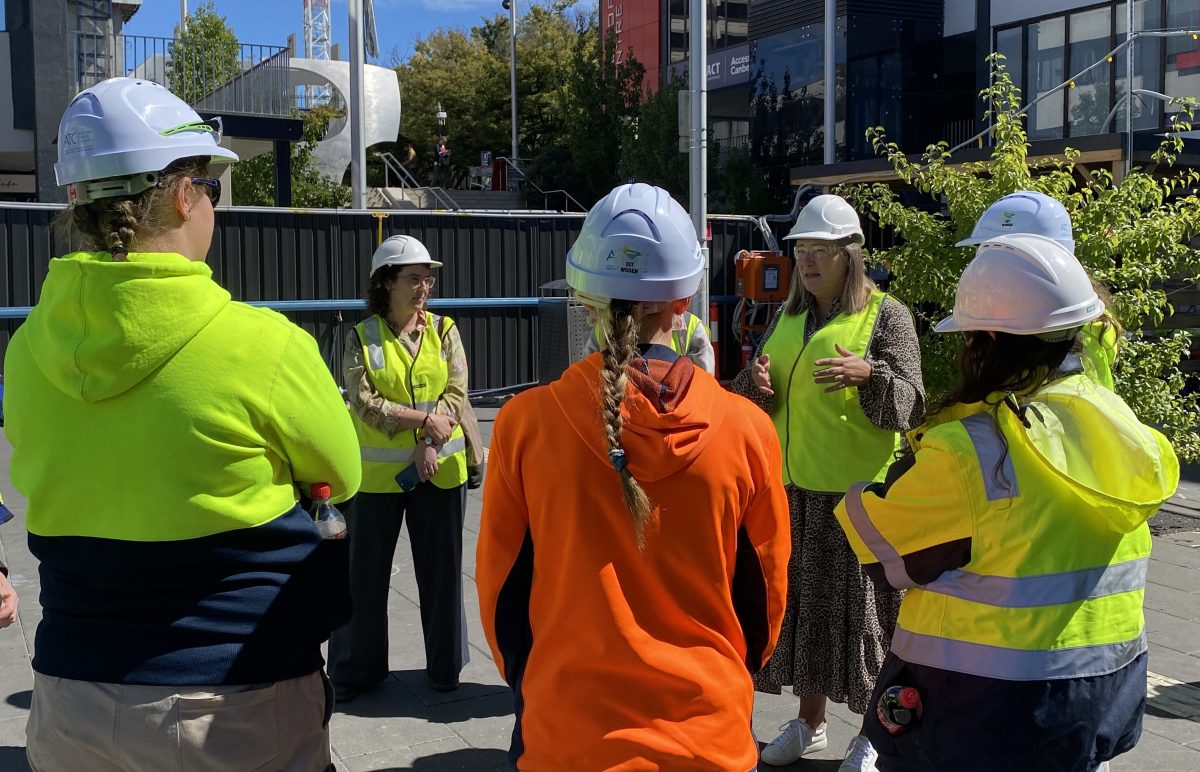
Construction sites should no longer be exclusion zones for women, with a number of initiatives to get more females into the workforce. Photo: Claire Fenwicke.
Construction companies may soon have to meet quota requirements to win government contracts as part of a move to get “gender on the tender”.
The ACT Government has opened consultation on the strategy, which is hoped to get more women on the tools in the industry and help alleviate skills shortages.
Special Minister for State Chris Steel said the government had proposed a 10 per cent target for the proportion of women employed in construction on ACT Government-backed projects estimated at $5 million or more.
“[Suggestions] include having a target of 30 per cent of women employed on construction projects, but also separate targets for different parts of the workforce,” he said.
“For example, a minimum target of 5 per cent has also been proposed for women in trades, and also a 20 per cent target of trade apprentices and trainees to be women.
“We’d like to hear from industry about what their thoughts are and whether the requirements should be minimum requirements or whether there should be a performance-based approach that we take in the future so that we see greater equality across the workforce.”
When asked why this was needed, given the tight labour market and skills shortages, Mr Steel said this was about reinforcing to industry that there was a willing workforce that may have been overlooked.
“I think this is really just about making sure that all construction firms do the same thing,” he said.
“For those firms who haven’t been thinking about this, they really should be because this is where we’re going to find the next carpenters, plumbers, all of the trades that are in desperate need to be able to build our city as it grows.”
CFMEU ACT construction division assistant secretary Michael Hiscox said this was a move the union had been calling for for years.
“The best way to make sure things get done is just set a clear target and say, ‘this is what we want to achieve’,” he said.
“For example, if we want a roof on a building, that’s a minimum requirement, so if we want to hit this target, I think we should make it a minimum requirement.”
Mr Hiscox welcomed the suggestion quota targets should be based on trade-based roles as the system had been played in the past.
“Previously, when we’ve had these targets set, some companies have tried to make it up just with administrative roles or people in traffic control roles, things like that,” he said.
“It’s pretty cool that women are actually going into roles where they’ll have skills. They’ll have longevity in the industry.”
But quotas can’t be met unless trained women actually exist to take on the roles.
Women currently comprise just 2 per cent of the construction workforce in the ACT.
Master Builders ACT pointed out procurement rules are only one piece of the puzzle.
“The MBA’s experience shows that attracting more women into the construction industry starts at school,” CEO Michael Hopkins said.
“It requires a change in attitude amongst career advisors and parents to support young girls into trade careers.
“It requires our Federal and Territory Governments to substantially increase funding for vocational education, including continued funding for pre-apprenticeship programs for women in construction.”

Minister for Women Yvette Berry speaking with Lendlease apprentices at the CIT Woden campus worksite. Photo: Claire Fenwicke.
Minister for Women Yvette Berry said the ACT Government was already taking these steps, pointing to its Women in Construction SPARK program and the Understanding Building and Construction pilot program in public schools.
“What we’ve been doing is developing this pipeline of young women, girls and gender diverse people for the construction industry, to take up a trade and trial a trade so when we get to this point of putting gender on the tender, there is the workforce there to do that,” she said.
The government and CFMEU have also partnered to deliver the Respecting Relationships program, an equality program to ensure women felt safe and included on worksites.
Another area flagged for improvement is making sure the building and construction industries are attractive for women to stay in them.
CIT Woden Lendlease project director Elyse Howard said her company had introduced a new 26-week paid parental leave policy to assure women their workplace was family friendly.
“[Parental leave] doesn’t differentiate between primary and secondary carers, so it’s allowing women and their partners to fully participate in home duties and also at work,” she said.
“It’s really the new norm for us to see so many females in the construction industry.”
Women make up 17 per cent of workers on the CIT Woden campus project, with trainees getting experience across a range of disciplines.
“We’ve got placements in civil, electrical, plumbing and also carpentry,” Ms Howard said.
“So we hope to see that that will be a trend throughout the industry, and no trade will get left behind.”
The proposed Women in Construction Procurement Policy is open for consultation until 17 May and is part of the ACT Women’s Plan 2016-26.


















